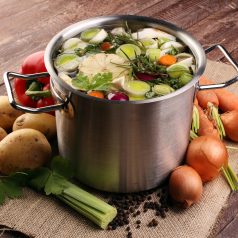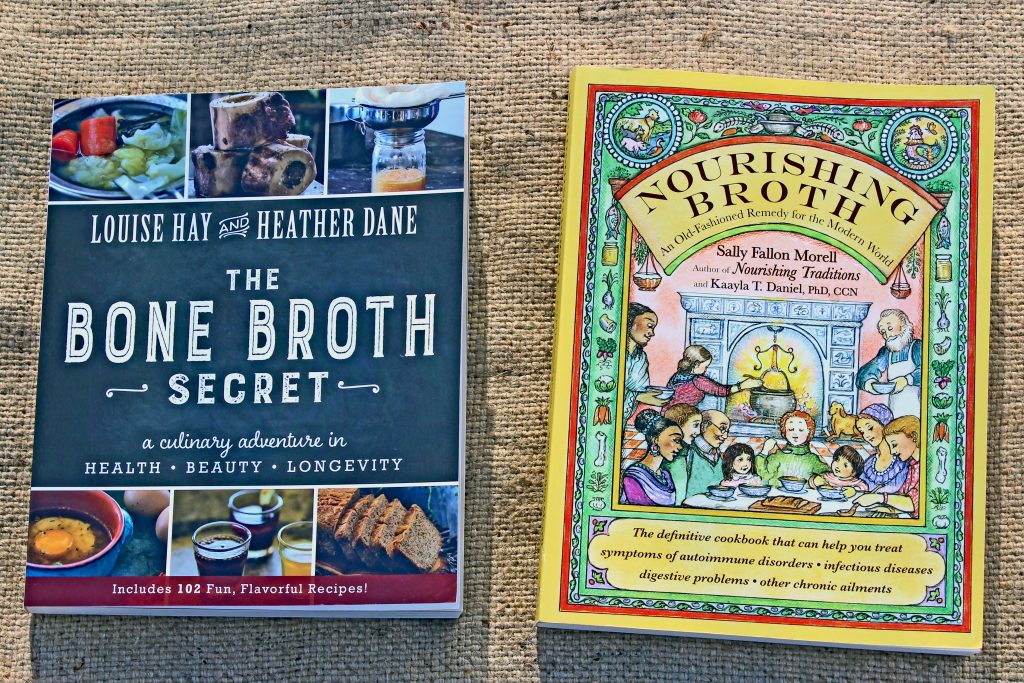
Bone Broth Benefits
Bone broth may be thousands of years old, but it’s arguably the hottest thing going in the food world right now. It’s being hailed by nutritionists and foodies alike for its irresistible depth of flavor and a jaw-dropping list of healing properties. Who doesn’t want to sip something delicious that also happens to boost immunity, squash inflammation, enhance energy, mental focus, and mood while improving their hair, skin, bones, teeth, and nails? It all sounds too good to be true for something so simple, right?
At its essence, bone broth is nothing more than a humble combination of bones and water simmered for a few hours. Of course, one can choose to spice it up by tossing in veggie scraps, cheese rinds, herbs, and seasonings, but it’s also fine to keep it simple. You won’t even need any fancy equipment. Just a large, deep (non-aluminum) pot or slow cooker, a colander or fine mesh strainer, and a long-handled spoon will suffice.
When choosing bones for your broth look for collagen and cartilage-rich bones like knuckles, feet, joints, necks, heads, and tails. It’s also great to add skins and/or meatier bones. Mixing leftover cooked bones from meals earlier in the week with raw bones is perfectly fine. Mixing bones from different kinds of animals is fine, too. You can brown, roast, or parboil your raw bones first, or just toss them in raw and naked as they came. Experts recommend using bones from organic, grass or pasture-fed animals to ensure your healing broth is free of antibiotics & hormones, and rich in all the wonderful things that come from an animal raised eating its natural diet.
Louise Hay and Heather Dane, authors of The Bone Broth Secret, recommend that you fill your pot 2/3 full with bones, cover the bones with filtered water, bring the water to a boil, reduce heat to a gentle simmer, and simmer for a minimum of 3 hours. Of course, if you’re including veggies or other add-ins, adjust the bone quantity accordingly.
When your bone broth is done, strain out the solids using a metal colander and reserve the remaining liquid in glass jars or similar containers. Once your broth is cooled, you’ll have a jiggly, gelatinized base with a fat cap on top. The fat cap helps preserve your broth, so keep it on top until you’re ready to consume it. You may choose to freeze your broth or use it right away. You may also choose to consume the fat cap, or skim it off. This fat is particularly healthy fat for consumption, so if you choose not to consume it as part of your broth, be sure to save it for using in other recipes. Now you can opt to sip your bone broth as-is, use it as a base for sauces, incorporate it into other recipes, or use it as a base for a soup. It’s very versatile!
Here are a few of the key reasons to incorporate bone broth into your diet:
- Bioavailable Collagen – You may be accustomed to seeing collagen-touting products in the face and body care aisle, but it turns out that this incredible protein is abundant in bone broth. The broth delivers it in a form that is already broken down into gelatin, which is easily digested and assimilated in the body. It is responsible for healthy skin, hair, nails, teeth, bones, joints, ligaments, and tendons. It also helps keep our muscles strong, aids cellular growth, helps normalize stomach acid, and supports the organs of our digestive system making it particularly healing for sufferers of conditions such as GERD (gastroesophageal reflux disease), leaky gut syndrome, and IBS (irritable bowel syndrome).
- Bioavailable Nutrients – The exact breakdown varies depending on the types of bones and other add-ins you use, but generally you can expect an abundant bounty of amino acids, minerals, vitamins, and healthy fats contributing to elevated mood, energy, focus, and hormone balance. These nutrients are conveniently delivered in predigested forms that are readily utilized by our bodies.
- Less Waste- Bone broth is kind to your budget and to our planet. Using all parts of an animal nose-to-tail is far less wasteful than if that animal is harvested only for the choice cuts of meat, especially when one considers the inputs required to raise that animal. Plus, the bones and cheaper cuts of meat are actually better for our bodies, containing more collagen, glycosaminoglycans, and essential fatty acids than the pricier, choice cuts of meat. When you use bones leftover from other meals, along with your veggies scraps from the week, you create something beautiful, flavorful, and healthy from items that would otherwise be destined for the compost pile. That’s really making the most of your food budget!
To learn more about the incredible benefits of bone broth and discover flavorful recipes, visit the book section of the Co-op and look for The Bone Broth Secret by Louise Hay & Heather Dane and/or Nourishing Broth by Sally Fallon Morell.

